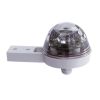Hydreon RG-15 Optical Rain Gauge
Features
- Features nominal accuracy of within 10% compared with tipping bucket
- Low power consumption makes it well-suited for solar charged applications
- RS-232 serial communications for configuration and data collection
- Expedited repair and warranty service
- Lifetime technical support
- More
Overview
The Hydreon RG-15 Solid State Tipping Bucket is a rainfall-measuring device intended to replace conventional tipping buckets. The RG-15 is rugged, reliable, maintenance-free and features a nominal accuracy of within 10%. The RG-15 is designed to replace tipping bucket rain gauges in many applications where their maintenance requirements make them impractical.
Design
The RG-15 uses beams of infrared light within a plastic lens about the size of a tennis ball. The round surface of the lens discourages the collection of debris, and the RG-15 has no moving parts to stick to, and no water-pathways to clog. The device features an open-collector output that emulates a conventional tipping bucket, as well as serial communications that provide more detailed data and allow for configuration of the device.
Mechanics
The RG-15 may be configured through the serial port, or optionally via DIP switches. Power consumption of the RG-15 is very low, and the device is well-suited to solar-power applications. Dip Switches can control the units (inches or millimeters) and resolution (0.01″/0.2mm or 0.001″/0.02mm) of the device. Commands can also be sent via the RS232 serial port to override them.
| Nominal Accuracy | ±10%1 |
| Input Voltage | Range 5-15 VDC 50V surge on J1 Reverse polarity protected to 50V Alternative 3.3VDC through pin 8 on J2 |
| Current Drain | 110 μA nominal. (No outputs on, dry not raining) 2-4 mA when raining |
| Output | NPN Open Collector Output 500 mA / 80V / 300mW Max |
| Operating Temperature | -40°C to +60°C (Will not detect rain when freezing) |
| Output Resolution | 0.01in / 0.2mm Alternative 0.001in / 0.02mm |
| RS232 Port | 3.3V |
| Supported Baud Rates | 1200, 2400, 4800, 9600, 19200, 38400, 57600 |
1Field accuracy will vary
In The News
Wave-Powered Buoy Deployed in Puget Sound
While the development of solar-powered monitoring systems has improved access to real-time environmental data, solar power is still limited by low light conditions, such as poor weather, nighttime, or high-latitude environments. To supplement these incumbent power solutions at sea, Ocean Motion Technologies has developed a small-scale ocean wave energy system that can be directly integrated with existing data buoy platforms. Not only does wave energy supplement solar power during periods when the buoys are limited by light availability, but it also allows data buoys to perform beyond their current power capacities.
Read MoreLong-Term Monitoring in the Chautauqua Lake Watershed
With a widely developed shoreline, Chautauqua Lake experiences influxes of non-point source pollution that have historically impacted the health of the lake. The Chautauqua Lake Association (CLA) has been monitoring the lake for over two decades, reporting on changes that have occurred over the years. A pair of local lake advocates, Jane and Doug Conroe, have lived on the lake for over 40 years and have played an important role in establishing monitoring programs and facilitating consistent data collection throughout the watershed. Doug has been involved with the Chautauqua Lake Association (CLA) since the pair moved to the area in 1980, and is currently serving as the Executive Director.
Read MoreNo Red Herrings: Data Driving the Largest Salt Marsh Restoration in the NE USA
The Herring River system encompasses around 1,000 acres in the Towns of Wellfleet and Truro, Massachusetts. In 1909, the Chequessett Neck Road dike was built at the river’s mouth, drastically limiting tidal flow. Today, it’s one of the most restricted estuaries in the northeastern United States. As a result, the area has suffered environmental decline, including poor water quality, hypoxia, lower pH, and salt marsh degradation. In 2023, the Town of Wellfleet received $14.7 million from NOAA’s Office of Habitat Conservation to fund the Herring River Restoration Project (HRRP). Francesco Peri, President and CEO at Charybdis Group LLC, uses a network of NexSens data loggers to monitor water level and water quality on the Herring River.
Read More







